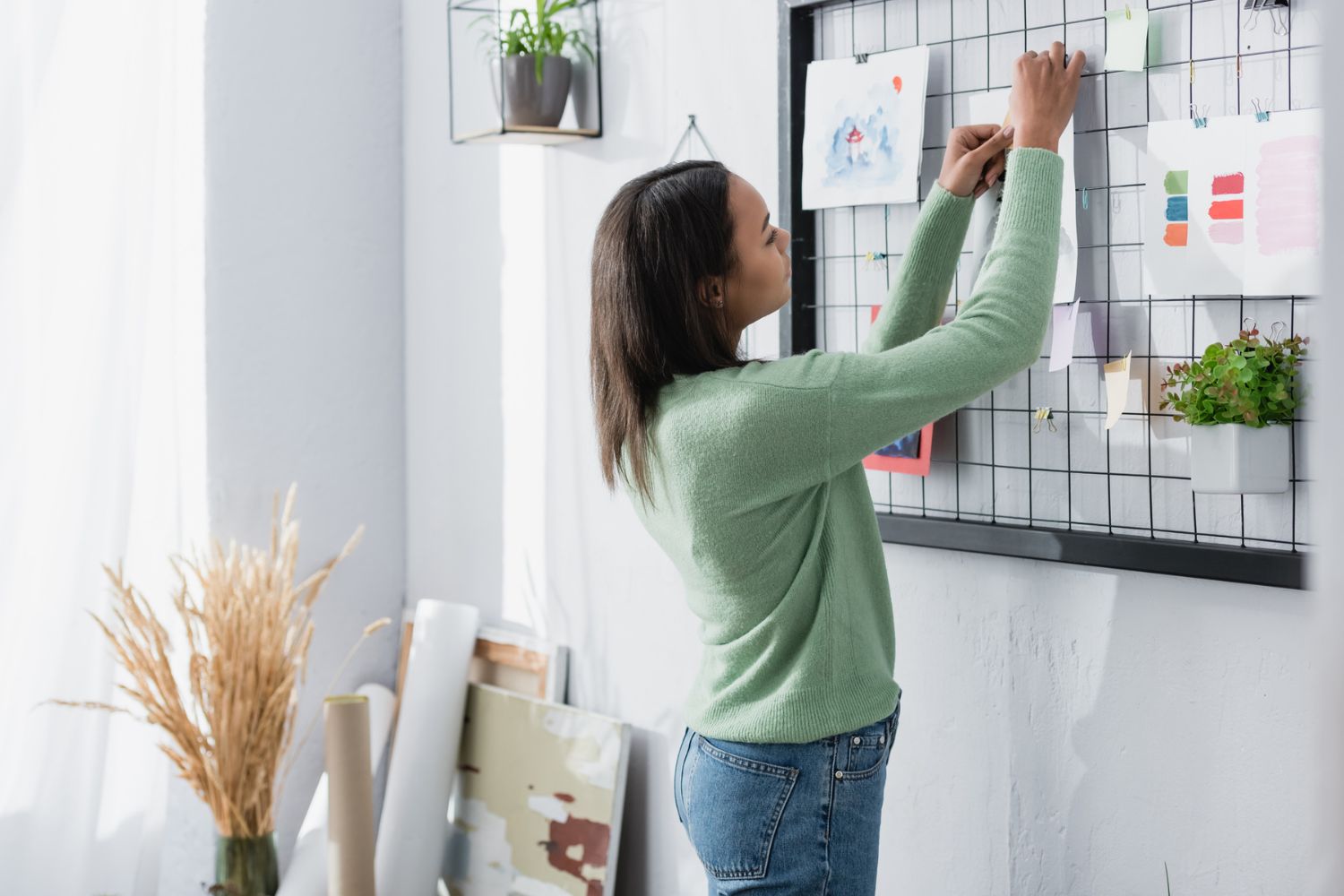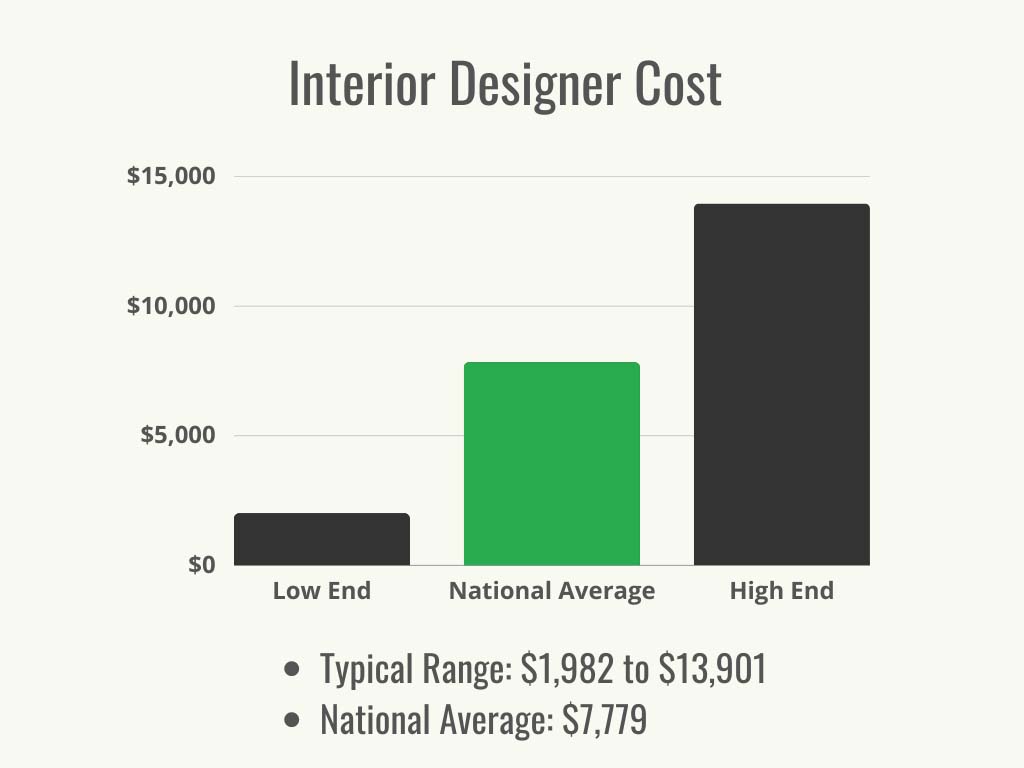We may earn revenue from the products available on this page and participate in affiliate programs. Learn More ›
Highlights
- The typical cost range to hire an interior designer is $1,982 to $13,901, with the national average cost at $7,779.
- There are several factors that determine the final cost of hiring a designer or decorator, including the type of room, the scope of the project, and the experience level of the designer.
- Hiring an interior designer or interior decorator has several advantages, including time and stress savings, a customized home aesthetic, and an increase in home value.
- While it is certainly possible for a homeowner to design their own interior, hiring a professional can result in a more functional space that serves the homeowner’s needs.
An interior designer can help a homeowner design and implement a home improvement project, managing contractors and ordering materials on behalf of the homeowner. Many people choose to spend money on interior designer costs for the peace of mind a designer can bring to what would otherwise be a stressful experience. But a designer’s expertise comes at a cost.
According to Angi and HomeAdvisor, the typical cost to hire an interior designer ranges between $1,982 to $13,901, with the national average price at $7,779. Of course, these cost factors can go up or down depending on where a person resides. For instance, what someone pays for an interior design consultation in New York City will differ from what someone else might pay in Baton Rouge. But even within the same state, some price differentiation may occur with more- prestigious clientele paying much more for top-notch upgrades to their homes.
Many people seek out the best interior design services to have beautiful decor and designs from room to room that make sense and provide a seamless flow. This guide covers the factors that go into the total interior designer cost, the benefits of hiring an interior designer, and advice on hiring the best pro for the job.
Interior Designer vs. Interior Decorator
Some people use the terms “interior designer” and “interior decorator” interchangeably. However, there is a difference between interior designers and interior decorators. Perhaps the most significant difference between the two is credentialing. An interior designer has to obtain formal training and is encouraged to get a license to practice, while an interior decorator doesn’t need either.
Another significant difference between the two is the point at which they get involved in a project. Interior designers have the skill and ability to work on a project from the very beginning, even during the design process when architects are drawing up plans. They ensure that the spaces are functional as well as aesthetically pleasing.
Interior decorators tend to get involved in the process long after the structural changes are complete. Unlike interior designers who can offer input on the functionality of a space, interior decorators are much more concerned with aesthetics, as well as with creating a home environment that reflects the owner’s design tastes.
In short, an interior designer is able to determine whether to eliminate a wall to make a space more functional, while an interior decorator determines whether to paint the wall or add wallpaper. Both are concerned with enhancing the space, but a designer may change the physical space while a decorator is focused on upgrading its appearance. Homeowners will want to carefully consider which professional is the best fit before searching online for “interior decorator near me.”

Factors in Calculating Interior Designer Cost
The cost to employ the services of an interior design consultant will range between $1,982 and $13,901, with the average cost nationwide at $7,779. But there are many factors that can drive the costs of interior design up or down. Some interior designers are self-employed, which could mean that their prices may be lower than those of an interior design firm. A large firm will generally have to charge extra to cover their overhead costs, including the cost of their employees and the cost to operate their showroom. On the flip side, the cost of a self-employed interior designer could be higher than what a firm would charge if that designer is well known in the industry.
Additionally, project scope, labor, quality and quantity of furnishings, geographic location, and additional fees can affect interior design prices. Interior designers are typically more costly to hire than decorators because their services are more extensive and they are often more highly trained. Some designers and decorators may charge for their services using different pay structures, like per hour or a flat fee. The following is a closer look at how various cost factors affect the bottom line.
Project Scope
The scope of the project is an important factor in calculating interior design costs. The bigger the project, the pricier it will likely be. Some interior design projects may last a few weeks, while others may last several months. A longer project will typically require more resources and therefore cost more. However, short projects can also be costly. For instance, if an interior designer typically completes a project in 4 months but the client needs it finished within 2 months, the rushed timeline can also drive up the price.
The extent of work needed can also affect the price. On average, interior designers charge between $5 and $15 per square foot, but they may charge a flat fee for smaller projects. If the interior designer doesn’t need to make any structural changes to the room, the cost will likely be on the lower end. But once they factor in adding or removing walls or windows, the price can increase quickly due to the additional time and labor required to do the job correctly. Interior decorator costs are typically charged by the hour, but prices come out to $5 to $12 per square foot.
Room Type
The cost of an interior designer can vary depending on the type of room or space being designed. This is partially due to the size of the space, but costs are also dependent on any special features or equipment that will be incorporated into the space. For instance, an entryway will be less costly to design than a large kitchen. Some companies specialize in designing only one part of the home, such as the best closet design companies. Homeowners will want to keep in mind that costs can vary based on whether designers or decorators are working within an existing home or designing from scratch for a new build.
| Room Type | Average Cost |
| Entryway | $449 to $699 |
| Bedroom | $539 to $1,299 |
| Office | $499 to $1,099 |
| Nursery | $499 to $1,099 |
| Living Room | $599 to $1,399 |
| Dining Room | $499 to $899 |
| Kitchen | $599 to $1,499 |
| Bathroom | $599 to $1,399 |
| Patio | $449 to $1,399 |
Labor and Additional Fees
Labor is often one of the most expensive costs in a design project. So how much does it cost to hire an interior designer? Some designers charge for labor by the hour, typically between $50 and $200. Interior decorators charge an hourly rate of $50 to $150. Other designers and decorators charge by the square foot or with a fixed flat fee. Besides labor, an interior designer may charge for the initial consultation, travel, drawing up an initial plan, and project management. Before the project begins, some firms may also require a down payment from the client equal to half of the projected amount, which can be a big lump sum out of pocket, depending on the scope of the project.
A homeowner may also have to pay for interior design images, depending on the pro they hire. Online designers have clients send photos of their current space so they can see what they are working with. Then, they will use technology to show an image of what the room would look like when all the updates are completed. Some designers may charge for these images, while others may build the cost into the consultation fee. Once the homeowner is happy with the mock-up images the designer has created, they will have a good idea of what their home will look like once the project is complete, which can give added peace of mind when paying for interior design services.
Quantity and Quality of Furnishings
Another cost factor in the design process is the cost of the furnishings, appliances, and other decor. Depending on the homeowner’s taste, budget, and what type of interior design styles they are looking for in the finished room, the interior decorator may need to opt for higher-quality furniture or one-of-a-kind custom pieces, which tend to cost more than mass-produced items. However, for a simpler project, the designer may be able to find what the homeowner is looking for at discounted prices, which can mean a lower overall cost for the interior designer services. Expect to budget $2,000 to $5,000 for furnishings on an interior design project.
Geographic Location
Geographic location can have a significant impact on the cost of interior design services. Costs in urban areas tend to be higher than in rural regions. Even within the same state, the cost can vary wildly based on the city; for example, residents of New York City are more likely to pay top dollar for an interior designer than those who live in Rochester, New York. Homeowners will also want to consider that hiring a designer from out of state may require paying for their travel and lodging. Homeowners who are looking to keep costs low may want to start by researching “interior designer near me.”
Designer Experience and Reputation
Interior design costs may increase exponentially based on the name of the individual or company working on the project. For example, a well-known interior designer who has appeared on TV or who works with famous celebrities may charge as much as $450 per hour for their interior design services, whereas a lesser-known designer who has just graduated from one of the best interior design schools may charge only $50 per hour. A designer who has built a solid reputation and portfolio can typically find clients who are willing to pay a premium to say they had their home designed by a famous name. If that is an important factor, homeowners will need to be prepared to pay top dollar.

Benefits of Hiring an Interior Designer or Decorator
Interior design is about more than just making a space look good. An interior designer can change the entire layout of a room to increase efficiency and aesthetics. For example, an interior designer can take a small, poorly designed bathroom and make it more functional by reconfiguring the pipes and electricity. They can even work with a professional contractor to remove or rearrange walls to open up for space in a small kitchen without compromising the structural integrity of the home.
Interior designers and decorators alike understand how all the parts of a room fit together. Not only do they know what colors work together, but they also know how lighting, textures, styles, sound, and negative space can all make a cohesive design. They’ll also be informed on the most up-to-date, modern interior design trends. Finally, they know how to help someone sell their space or make valuable upgrades to their home by determining which parts of the house to enhance to get the best return on investment.
Time and Stress Savings
Interior designers do much more than dream up room layouts, although that is one important facet of their work. In the process of seeing the project through to completion, designers can act as project managers who find subcontractors, place orders, and make sure the work stays on schedule. They also have contacts and resources that a homeowner likely does not. For instance, they’ll know who to call for custom furnishings and how to get materials at a discount, saving homeowners time, money, and sanity.
Customized Aesthetic
Many people hire an interior designer for their artistic ability. Whether the space is small or large, an interior designer will know the best approach to making it work effectively while keeping in line with the client’s personal style preferences and budget. An interior decorator can use their expertise to choose the right blend of fabrics, textures, furniture, and more to create a unique space that fits the client’s aesthetic and looks customized rather than cookie-cutter.
Increased Functionality
The wrong furniture or decor can have a huge impact on a room’s functionality. Not only can an interior designer determine ways to physically increase the size and functionality of a room, but they can also use color, furniture, and decorative elements to improve the functionality of a space. They can also make use of negative space to balance the furniture in the room, using their experience and knowledge to help clients more effectively use the space in their homes.
Increased Home Value
Interior designers can help increase the value of a house when it’s being sold. Buyers gauge their interest in a home based on pictures posted online, and if the house they’re considering is drab and old-fashioned or has an odd layout, they’re less likely to want to view it in person. An interior designer can help a property stand out to potential buyers by playing up the home’s best features and updating any features that might be considered dated. Interior decorators can also help with staging a home tastefully, making it more attractive to buyers. Not only will a home that’s been updated by an interior designer catch the attention of more buyers, but it could result in a higher selling price as well. In this case, the higher selling price may even cover the interior designer costs while still giving the seller a higher profit.

Interior Designing and Decorating: DIY vs. Hiring a Professional
Hiring an interior designer or decorator may seem like a luxury to many homeowners. Depending on the extent of the redesign, a homeowner may very well be able to complete basic projects themselves with the help of one of the best interior design apps. However, hiring a professional can end up saving homeowners time and money, especially on larger-scale home renovation projects. Many homeowners start DIY projects with the best intentions but find that it takes them months or years to complete the project—if they are able to finish it at all. Quick design fixes before listing a home can cause problems in the future for the new homeowners if the project was rushed or not completed by a professional. Home inspections may show that add-ons were done without the correct permits, or that an important structural wall has been removed improperly. This can affect the home’s marketability, stagnate the selling process, and even lead to legal problems.
Alternatively, an interior designer can manage the entire project, taking care of hiring other contractors as needed and ensuring that the project stays on track and is finished on time.
A professional interior designer has the skills to reconfigure a space to be more functional, while also choosing coordinating furniture and artwork to enhance the aesthetic of the house. If the project involves any structural work, it is inadvisable for the homeowner to take on the project alone since even a small mistake can cause expensive (and potentially dangerous) problems down the road. Interior designers also know which types of projects require permits and can take care of that process, whereas a DIY homeowner may not even realize a permit is needed in the first place, which can cause legal issues later on.
DIYers may especially feel confident that they can do their own interior decorating—looking at home interior decor inspiration online can make the process look easy. But while it’s true that homeowners know their own tastes and preferences best, a professional interior decorator can translate their ideas into a cohesive design that elevates the space. They’ll also be able to help their clients find unique decor and furniture, possibly even at a discount. Whether building a home from scratch or making minor cosmetic changes, hiring an interior designer or decorator can make the spaces where homeowners spend the majority of their time more comfortable, functional, and beautiful.
How to Save Money on Interior Designer Cost
Home renovation costs can add up when homeowners are utilizing the expertise of an interior designer. While the average cost to hire an interior designer is $7,779, that price can go up exponentially depending on the designer and the type and quality of items they plan to use in the project. For instance, a large home in a luxurious area may require a much more pricey interior design project to suit the neighborhood and the home’s elegant design. In this case, decorators may choose more expensive pieces from high-end designers rather than relying on pieces from discount retailers, which could drive up the prices significantly. This could pay off when the time comes to sell the home because it wouldn’t be good taste to have a million-dollar home staged with cheap furniture and accessories.
Not all interior design projects will require glamorous purchases, however. For those who want luxurious pieces but are on a tight budget, consider the following tips for saving on interior design costs.
- Shop around for decor. Consider purchasing the products yourself, including appliances and furniture, to avoid paying a commission to the interior designer.
- Take on some of the work. If you have some basic decorating or construction skills, offer to help out with the labor on some of the projects.
- Stick to lower-cost options. Choose cheaper mass-produced items, like windows, doors, or furniture, when possible over more expensive custom ones.
- Split the work. Hire the interior designer or decorator on a consultation basis and take over the project management aspect yourself.
- Search for discounts. Ask the interior designer if they will offer a discounted rate, or if they have any discounts on furnishings that you can take advantage of.
- Consider repurposing. See if the decorator will repurpose furniture items you own rather than buying new. For example, reupholstering an old chair will typically cost less than buying a brand-new one, and it will also save the chair from potentially ending up in the landfill.
- Take it in stages. Stick to remodeling one room at a time rather than several rooms at once.
- Design online. If the project is straightforward, use an online interior design service or the best interior design software to plan your project and do the bulk of the work yourself.

Questions to Ask When Hiring an Interior Designer or Decorator
When preparing to hire interior designers and decorators, it’s important for homeowners to do research to find candidates within budget and whose style matches the home. After all, someone searching for a low-cost tiny-house interior design will have much different needs than someone remodeling a high-end luxury condo. Once the homeowner has a few front-runners, it’s a good idea to contact each of them to talk about the project.
Homeowners will also want to ask specific questions based on their needs and design tastes. This might include questions like, “How will you determine the color palette for my home?” or “How will you use natural or artificial lighting to improve the overall look of my rooms?” In addition to those important questions, here are some standard questions to ask.
Questions to ask an interior designer:
- Can you tell me more about your experience in interior design?
- How long have you been in the business?
- Are you certified and licensed with the American Society of Interior Designers, National Council for Interior Design Qualification, or Certified Interior Decorators?
- Are you insured?
- What interior design services do you offer?
- How do you charge for your services?
- Do you require a down payment for your services?
- What kind of budget is necessary for a project like this?
- How long will my project take?
- Can I see your portfolio of work?
- What styles and colors do you like most?
- Am I able to speak with a few of your references?
Questions to ask an interior decorator:
- What degree or certifications do you have?
- Can you describe your aesthetic?
- Have you completed projects similar to this one before?
- Can I see your portfolio?
- How does payment work?
- How will you stay within my budget?
- How long will this project take?
- How do I choose a rug size?
- Does my furniture need to match my hardwood floors?
- Where can I find good deals on furniture and decor?
- What advice do you have about mixing patterns?
FAQs
Interior designers and decorators don’t only work on castles or fancy estates. Interior designers are skilled at helping any homeowner fill their space with exciting, unique pieces of furniture and art while maximizing the functionality of the space. Using negative space and other design elements, an interior designer or decorator can help make a room appear open and inviting rather than cramped and cluttered.
Hiring an interior designer is a big decision, and it can be a significant expense, so it’s important that homeowners understand the process and find the right professional for the project before signing any contracts. The frequently asked questions below will be a guide to help homeowners learn more about what to expect during the process.
Q. How much does an interior designer cost on average?
On average, homeowners can expect to pay around $7,779 for interior design. This cost can go up or down depending on several factors, including square footage of the space, labor charges, the costs of materials, the designer, the scope of the project, and more. Some designers may charge hourly fees, while others may charge by square footage. It’s important that homeowners understand how the designer calculates their fees before agreeing to pay them for any work.
Q. Will interior designers suggest different styles?
Interior designers have professional knowledge of acoustics, temperature, lighting, and more, so their suggestions will be based on more than just style. They will make suggestions based on clients’ tastes and the type of design they prefer. But homeowners will also need to be prepared for the designer to be blunt about what works and what doesn’t. While they help bring their clients’ interior design ideas to life, they also want the design to make sense. Therefore, if colors do not work or styles clash, many designers will explain why and make suggestions for more balanced results.
Q. How do I know if I need an interior designer?
Often, people conclude that there isn’t much to painting walls or adding furniture to the rooms in their house. In some homes, this may be true. However, homeowners who want to sell their house in the near future may find that hiring a house interior designer can be a good idea. A designer can observe the space and help designs come together as organized and harmonious, which can make the home more attractive to potential buyers if the home will be going on the market soon.
Q. Will I be involved in the interior design process?
Homeowners can expect to be involved in the interior design process at various stages. They will initially be involved in the meeting or programming stage. This meeting is for clients to discuss their goals and design tastes with the designer so that they can begin to work on a plan for the project. During the middle stages of the process, including the work stage, the homeowner will have minimal involvement. While they may be open to some design changes, an interior designer will explain how the changes could affect the timeline and budget. If the client is willing to accept the possible delays and price increases, the designer may make concessions. One final part of the process that will involve the homeowner is the reveal; this is where the interior designer shows off the results of all their hard work.
Q. Do interior designers need a license?
Most states don’t require interior designers to have a license. However, it is possible for designers to be licensed, and those who have a license have additional clout. Interior designers deal with not only the aesthetics of a space but also the functionality, which may involve changing the physical characteristics of a space. Since they are authorized to make changes to the structure of a building, having proper credentials shows that they can make such changes without causing code violations and hazards.
Q. Should an interior designer give me an estimate before starting the work?
Before starting on any project, most professional home designers will inspect the space and potentially do an on-the-spot consultation. Once all the plans have been worked out, the interior designer will provide an estimate for the work that they plan to perform. The costs could include design work for the entire house or costs of remodeling any room in the house. When a client agrees to the work, the designer will present a contract that includes the estimate’s details and any other pertinent information. Interior designing contracts are binding once clients sign them.
Q. Does an interior designer work with other professionals?
Yes. An interior designer typically works with other professionals such as architects, construction teams, civil and mechanical engineers, building contractors, and project managers. They can read, draw, and edit blueprints. They are also knowledgeable of building codes and are aware of ADA (Americans with Disabilities Act) standards. Therefore, interior designers aren’t only concerned with the beauty of a space but also its functionality and conformity to building codes.
Sources: Angi, HomeAdvisor (1 and 2), HomeGuide, Fixr, Thumbtack


